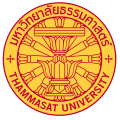Dharmachakra
| Part of a series on |
| Buddhism |
|---|
 |

The dharmachakra (
Historically, the dharmachakra was often used as a decoration in
Etymology
The Sanskrit noun dharma (धर्म) is a derivation from the root dhṛ 'to hold, maintain, keep',[8] and means 'what is established or firm'. The word derives from the Vedic Sanskrit n-stem dharman- with the meaning "bearer, supporter". The historical Vedic religion apparently conceived of dharma as an aspect of Ṛta.[9]
History and usage
Similar chakra (spoked-wheel) symbols are one of the most ancient in all Indian history. Madhavan and Parpola note that a wheel symbol appears frequently in
Some historians associate the ancient chakra symbols with solar symbolism.[13] In the Vedas, the god Surya is associated with the solar disc, which is said to be a chariot of one wheel (cakra). Mitra, a form of Surya, is described as "the eye of the world", and thus the sun is conceived of as an eye (cakṣu) which illuminates and perceives the world.[14] Such a wheel is also the main attribute of Vishnu.[12] Thus, a wheel symbol might also be associated with light and knowledge.
Buddhist usage and significance
In Buddhism, the Dharma Chakra is widely used to represent the Buddha's
The Buddha is said to have set the "wheel of dharma" in motion when he delivered his first sermon,
In his explanation of the term "turning the wheel of Dharma", the Theravada exegete

In the
There are different designs of the Buddhist dharmachakra with 8, 12, 24 or more spokes. In different Buddhist traditions, the different number of spokes may represent different aspects of the Buddha's Dharma (teaching). In the Indo-Tibetan Buddhist tradition for example, the 8 spoked wheel represents the noble eightfold path, and the hub, rim and spokes are also said to represent the three trainings (sila, prajña and samadhi).[20]
In Buddhism, the cyclical movement of a wheel is also used to symbolize the cyclical nature of life in the world (also referred to as the "wheel of
The spokes of a wheel are also often used as symbols of the Buddhist doctrine of dependent origination. According to the Theravada scholar Buddhaghosa:
“It is the beginningless round of rebirths that is called the ’Wheel of the round of rebirths’ (saṃsāracakka). Ignorance (avijjā) is its hub (or nave) because it is its root. Ageing-and-death (jarā-maraṇa) is its rim (or felly) because it terminates it. The remaining ten links [of Dependent Origination] are its spokes [i.e. saṅkhāra up to the process of becoming, bhava].”[14]
The earliest Indian monument featuring dharmachakras are the Ashokan Pillars, such as the lion pillar at Sanchi, built at the behest of the Mauryan emperor Ashoka. According to Benjamin Rowland:[14]
”The Sārnāth column may be interpreted, therefore, not only as a glorification of the Buddha’s preaching symbolised by the crowning wheel, but also through the cosmological implications of the whole pillar as a symbol of the universal extension of the power of the Buddha’s Law as typified by the sun that dominates all space and all time, and simultaneously an emblem of the universal extension of Mauryan imperialism through the Dharma. The whole structure is then a translation of age-old Indian and Asiatic cosmology into artistic terms of essentially foreign origin and dedicated, like all Asoka’s monuments, to the glory of Buddhism and the royal house.”
According to Harrison, the symbolism of "the wheel of the law" and the order of Nature is also visible in the Tibetan prayer wheels. The moving wheels symbolize the movement of cosmic order (ṛta).[22]
Jain, Hindu and modern Indian usages


The dharmachakra is a symbol in the
Wheel symbolism was also used in Indian temples in places that underwent a religious transformation from Buddhism,[26][27] such as Jagannath temple, whose deity is believed by some scholars to have a Buddhist origin.[28][29] It also finds use in other ancient temples of Odisha, the most famous of which is the Konark Sun Temple.
The 24 spoke Ashoka dharmachakra is present in the modern flag of India, representing the pan-Indian concept of Dharma.[30] The modern State Emblem of India is a depiction of the Lion Capital of Ashoka (Sanchi), which includes the dharmachakra. An integral part of the emblem is the motto inscribed in Devanagari script: Satyameva Jayate (English: Truth Alone Triumphs).[31] This is a quote from the Mundaka Upanishad,[32] the concluding part of the Vedas.
Sarvepalli Radhakrishnan, the first Vice President of India, stated that the Ashoka Chakra of India represents the "wheel of the law of dharma", as well as "Truth or satya", "Virtue" as well as "motion", as in the "dynamism of a peaceful change".[30]
Other uses and similar symbols
- The main attribute of Vishnu is a wheel like weapon called the Sudarśanacakra.[12]
- Similar wheel symbols were used as a solar symbol by the Ancient Egyptians.[33]
- Some Buddha statues also depict the related Dharmachakra Mudrā, a hand sign depicting the turning of the Dharma wheel.
- A very similar wheel symbol also appears in the flag of the Romani people, hinting to their nomadic history.
- In non-Buddhist cultural contexts, an eight-spoked wheel resembles a traditional ship's wheel. As a nautical emblem, this image is a common sailor tattoo, which may be misidentified as a dharmachakra or vice versa.
- The sonnenrad is a similar symbol used by occultists and neo-nazis.
- Falun Gong uses the concept of a similar wheel as a central concept
- In the Unicode computer standard, the dharmachakra is called the "Wheel of Dharma" and found in the eight-spoked form. It is represented as U+2638 (☸). As emoji: ☸️.
Gallery
Historical and archeological examples
-
Reconstitution of approximate layout of Sanchi at the time of the Mauryas, showing the pillar topped by a dharmachakra.
-
Illustrated reconstruction of the pinnacles at Bharhut by Alexander Cunningham
-
Eastern gateway of Bharhut stupa topped with a dharmachakra pinnacle
-
Buddha represented by Dharmacakra,Sanchi Stupano. 3.
-
Dharmacakra on Pillar, Sanchi Stupa no. 3
-
Adoration of the pillar of Ashoka, Sanchi Stupa no. 3.
-
Illustration from Sanchi Stupa
-
Limestone Pilaster, 2nd century CE, Amravati, Indian Museum, Kolkata.
-
Buddha footprints with dharmachakras, Archaeological Museum, Amaravati
-
1st century Gandhara Buddha footprint
-
Stele from Gandhara
-
A sculpture depicting the dharmachakra in the museum ofAmaravathi
-
Taxila coin with wheel and Buddhist symbols
-
Coin found in Afghanistan, 50 BCE – c. 30 CE, at the latest before 50 CE.
-
Three Jewels, or Triratna. Eastern Afghanistan.Kushan period. 2–3 century.
-
Dharmachakra Pravartana Mudra, Gupta period, 5th CE.
-
Dhammacakka, National Museum, Bangkok, Thailand
-
Dhammacakka, National Museum, Bangkok, Thailand
-
Khao Klang Nai, Si Thep Historical Park, Thailand.
-
Mon dharmachakra, VII or IX century, Sandstone
-
Dharma wheel, Japan, Kamakura period, 1200s CE, bronze – Tokyo National Museum.
-
Part of a Buddha-statue, showing the first five disciples of the Buddha at Sarnath and dharmachakra.
-
Japanese dharmachakra, late 13th century.
-
Mandala Base, China, Ming dynasty, Cleveland Museum of Art.
-
Dharma wheel, China, Qing dynasty, Qianlong period, 1736–1795 CE.
-
Box with Ink Cakes: Yellow Ink Stick, China, Qing dynasty (1644–1912).
-
Dharmachakra Pravartana at National Museum, New Delhi
Contemporary examples
-
Jokhang Monastery
-
Wat Phothivihan, Tumpat, Kelantan
-
Entrance to Wat Phra Sing
-
Seal ofChai Nat Province (a garuda upholding the dhammacakka in front of the mountain and river), Wat Sri Suphan, Chiang Mai
-
Dharmachakra at Boudanath
-
Dhammacakka on Main Gable, Wat Phra Putthabat Tak Pha, Lamphun
-
Entrance to the Global Vipassana Pagoda
-
Lok Sabha chamber of the New Parliament building, New Delhi
National flags and official symbolism
-
Thepadma, blue khata and the Soyombo symbol
-
The Emblem of Sri Lanka, featuring a blue dharmachakra as the crest
-
TheEmblem of India, featuring the Ashoka Chakraon the base panel representing the Dharmachakra
-
Emblem of the Supreme Court of India, which shows the dharmachakra on top of the Lion Capital. It was found broken during the excavations.
-
The flag of the former Kingdom of Sikkim featured a version of the Dharmachakra
-
Emblem of Central Tibetan Administration with Tibetan Buddhist style Dharmachakra
-
The dhammacakka flag, the symbol of Buddhism in Thailand
-
The seal of Thammasat University in Thailand consisting of a Constitution on phan with a twelve-spoked dhammacakka
-
Colours of the National Scout Organization of Thailand
-
Flag used by the IndianDalit Buddhist Movement
-
The insignia for Buddhist chaplains in the United States Armed Forces.
-
Wheel inJain Symbol of Ahimsarepresents dharmachakra
-
USVA headstone emblem 2
-
Flag of the Romani People. It contains blue and red colour to represent the heaven and earth respectively, and uses a 16 spoke Dharmachakra to symbolise their tradition and to pay homage to their Indian origin.
Notes
- Harappan civilisation.[11]Therefore interpreting these symbols as spoked wheel is a matter of debate.
- ^ a b Grünwedel e.a.:"The wheel (dharmachakra) as already mentioned, was adopted by Buddha's disciples as the symbol of his doctrine, and combined with other symbols—a trident placed above it, etc.—stands for him on the sculptures of the Asoka period."[15]
- ^ Goetz: "dharmachakra, symbol of the Buddhist faith".[16]
References
- ^ a b John C. Huntington, Dina Bangdel, The Circle of Bliss: Buddhist Meditational Art, p. 524.
- ^ "Buddhist Symbols". Ancient-symbols.com. Retrieved 22 June 2018.
- ISBN 978-1015025486.
- ^ Nayak, Dr. Ganeswar (11 March 2014). "History of Odisha (From earliest times to 1434 A.D)" (PDF). Paralakhemundi: Shri Krushna Chandra Gajapati Autonomous College. p. 107.
- ISBN 978-0195148923.
- OCLC 1391872675.
- ^ "Dharma And Ethics The Indian Ideal Of Human Perfection 1st Published". priscilla.work. Archived from the original on 29 October 2021. Retrieved 29 October 2021.
- Monier Williams, A Sanskrit Dictionary (1899): "to hold, bear (also: bring forth), carry, maintain, preserve, keep, possess, have, use, employ, practise, undergo"
- ^
Day, Terence (1 January 2006) [1982]. "The Concept of Obligation". The Conception of Punishment in Early Indian Literature. Editions SR (volume 2). Waterloo, Ontario: Wilfrid Laurier University Press. p. 42. ISBN 9780889208384. Retrieved 5 March 2024.
The importance of the conception of Dharma in early brāhmanic thought is so considerable that it has seemed either that it replaced Ṛta as the leading philosophical and religious conception or that the earlier concept was at some time absorbed into it. It is probably more true that Dharma was conceived as an aspect of Ṛta which became so useful for framing religious, moral and social regulations, that interest in it and discussion of its applications to social and moral order eclipsed all discussions of metaphysical and theological ideas.
- ^ a b The Ancient Indus Valley: New Perspectives By Jane McIntosh. p. 377
- ^ Shahane, Girish (8 October 2014). "What the absence of chariots in ancient Harappa means for Modi's Clean India plan". Scroll.in. Archived from the original on 10 October 2014. Retrieved 16 January 2024.
- ^ a b c d Beer 2003, p. 14.
- ^ Issitt, Micah. Main, Carlyn. (2014). Hidden Religion: The Greatest Mysteries and Symbols of the World's Religious Beliefs, ABC-CLIO, p. 185.
- ^ a b c d e f g h T. B. Karunaratne (1969), The Buddhist Wheel Symbol, The Wheel Publication No. 137/138, Buddhist Publication Society, Kandy • Sri Lanka.
- ^ a b c Grünwedel, Gibson & Burgess 1901, p. 67.
- ^ a b Goetz 1964, p. 52.
- ^ a b Pal 1986, p. 42.
- ^ a b Ludowyk, E.F.C. (2013) The Footprint of the Buddha, Routledge, p. 22.
- ^ Issitt, Micah. Main, Carlyn. (2014). Hidden Religion: The Greatest Mysteries and Symbols of the World's Religious Beliefs, ABC-CLIO, p. 186.
- ^ A Lamp Illuminating the Path to Liberation: An Explanation of Essential Topics for Dharma Students by Khenpo Gyaltsen (translated by Lhasey Lotsawa Translations, Nepal: 2014, pp. 247–248).
- ^ Sargeant, Winthrop (2009), The Bhagavad Gita, SUNY Press, p. 303.
- ^ Harrison 2010, p. 526.
- Oxford University
- ^ Asha Kalia, Art of Osian Temples: Socio-economic and Religious Life in India, 8th–12th Centuries A.D. Abhinav Publications, 1982, chapter 16.
- ^ Sharma, Savita (1990). Early Indian Symbols: Numismatic Evidence, Agam Kala Prakashan, 1990 p. 51.
- ^ Misra 2007.
- ^ Sahu 1958.
- ^ Nayak 2014.
- ^ Mansinha 2021.
- ^ a b c "The national flag code" (PDF). Mahapolice.gov.in. Archived from the original (PDF) on 15 December 2017. Retrieved 22 June 2018.
- ^ Kamal Dey v. Union of India and State of West Bengal (Calcutta High Court 2011-07-14), Text.
- ^ "Rajya Sabha Parliamentary Standing Committee On Home Affairs: 116th Report on The State Emblem Of India (Prohibition Of Improper Use) Bill, 2004" (PDF). Archived from the original (PDF) on 8 March 2013.
- ISBN 978-1-59605-593-3.
Sources
- Anthony, David W. (2007), The Horse The Wheel and Language. How Bronze-Age Riders From The Eurasian Steppes Shaped The Modern World, Princeton University Press
- Beer, Robert (2003), The Handbook of Tibetan Buddhist Symbols, Serindia Publications, Inc., ISBN 978-1932476033
- Day, Terence P. (1982), The Conception of Punishment in Early Indian Literature, Ontario: Wilfrid Laurier University Press, ISBN 0-919812-15-5
- Goetz, Hermann (1964), The art of India: five thousand years of Indian art, Crown
- Grünwedel, Albert; Gibson, Agnes C.; Burgess, James (1901), Buddhist art in India, Bernard Quaritch
- Harrison, Jane Ellen (2010) [1912], Themis: A Study of the Social Origins of Greek Religion, Cambridge University Press
- ISBN 9781136875908
- Inden, Ronald (1998), Ritual, Authority, And Cycle Time in Hindu Kingship. In: JF Richards, ed., "Kingship and Authority in South Asia", New Delhi: Oxford University Press
- Mallory, J.P. (1997), Encyclopedia of Indo-European Culture, London: Fitzroy Dearborn Publishers, ISBN 978-1-884964-98-5
- Nath, Vijay (March–April 2001), "From 'Brahmanism' to 'Hinduism': Negotiating the Myth of the Great Tradition", Social Scientist, 29 (3/4): 19–50, JSTOR 3518337
- Pal, Pratapaditya (1986), Indian Sculpture: Circa 500 B.C.–A.D. 700, University of California Press, ISBN 9780520059917
- Queen, Christopher S.; King, Sallie B. (1996), Engaged Buddhism: Buddhist liberation movements in Asia., SUNY Press, ISBN 9780791428443
- Samuel, Geoffrey (2010), The Origins of Yoga and Tantra. Indic Religions to the Thirteenth Century, Cambridge University Press
- Yan, Xiaojing (2009), The confluence of East and West in Nestorian Arts in China. In: Dietmar W. Winkler, Li Tang (eds.), Hidden Treasures and Intercultural Encounters: Studies on East Syriac Christianity in China and Central Asia, LIT Verlag Münster, ISBN 9783643500458
Further reading
- Dorothy C. Donath (1971). Buddhism for the West: Theravāda, Mahāyāna and Vajrayāna; a comprehensive review of Buddhist history, philosophy, and teachings from the time of the Buddha to the present day. Julian Press. ISBN 0-07-017533-0.
External links
 Media related to Dharmacakra at Wikimedia Commons
Media related to Dharmacakra at Wikimedia Commons

















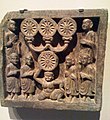




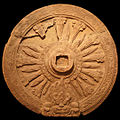
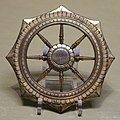









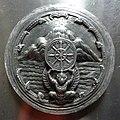








![The Flag of India has the Ashoka Chakra at its center representing the Dharmachakra.[30]](http://upload.wikimedia.org/wikipedia/en/thumb/4/41/Flag_of_India.svg/120px-Flag_of_India.svg.png)



